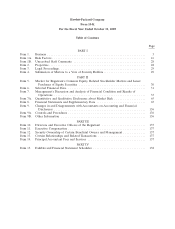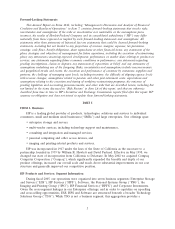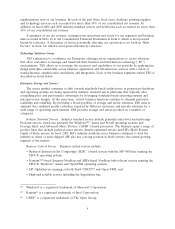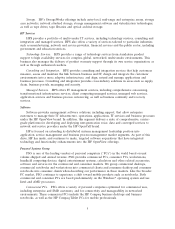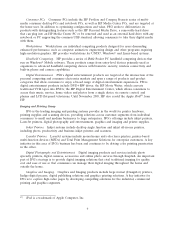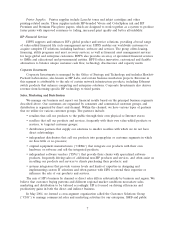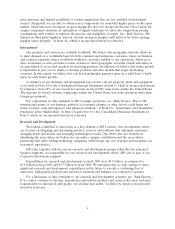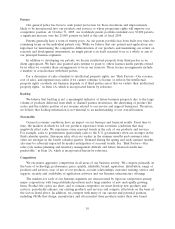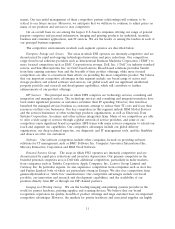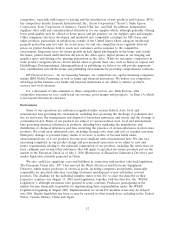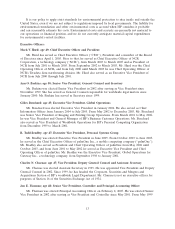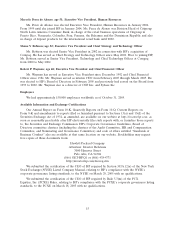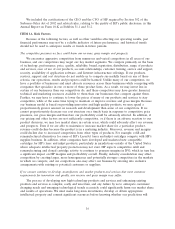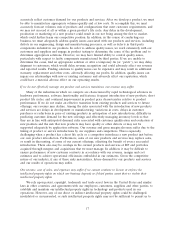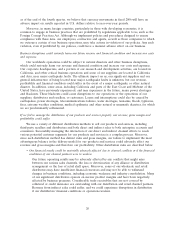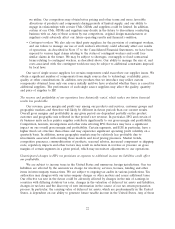HP 2005 Annual Report Download - page 16
Download and view the complete annual report
Please find page 16 of the 2005 HP annual report below. You can navigate through the pages in the report by either clicking on the pages listed below, or by using the keyword search tool below to find specific information within the annual report.competitive, especially with respect to pricing and the introduction of new products and features. IPG’s
key competitors include Lexmark International, Inc., Xerox Corporation (‘‘Xerox’’), Seiko Epson
Corporation, Sony Corporation of America, Canon USA, Inc. and Dell. In addition, independent
suppliers offer refill and remanufactured alternatives for our supplies which, although generally offering
lower print quality, may be offered at lower prices and put pressure on our supplies sales and margins.
Other companies also have developed and marketed new compatible cartridges for HP’s laser and
inkjet products, particularly in jurisdictions outside of the United States where adequate intellectual
property protection may not exist. In recent years, we and our competitors have regularly lowered
prices on printer hardware both to reach new customers and in response to the competitive
environment. Important areas for future growth include digital photography in the home and outside
the home, printer-based multi-function devices in the office space, digital presses in our imaging and
graphics space and driving color printing penetration in the office. While we encounter competitors in
some product categories whose current market share is greater than ours, such as Xerox in copiers and
Heidelberger Druckmaschinen Aktiengesellschaft in publishing, we believe we will provide important
new contributions in both the home and publishing environments by providing comprehensive solutions.
HP Financial Services. In our financing business, our competitors are captive financing companies,
mainly IBM Global Financing, as well as banks and financial institutions. We believe our competitive
advantage in this business over banks and financial institutions is our ability to finance products,
services and total solutions.
For a discussion of risks attendant to these competitive factors, see ‘‘Risk Factors—The
competitive pressures we face could harm our revenue, gross margin and prospects,’’ in Item 1A, which
is incorporated herein by reference.
Environment
Some of our operations use substances regulated under various federal, state, local and
international laws governing the environment, including laws governing the discharge of pollutants into
the air and water, the management and disposal of hazardous substances and wastes and the cleanup of
contaminated sites. Many of our products are subject to various federal, state, local and international
laws governing chemical substances in products, including laws regulating the manufacture and
distribution of chemical substances and laws restricting the presence of certain substances in electronics
products. We could incur substantial costs, including cleanup costs, fines and civil or criminal sanctions,
third-party damage or personal injury claims, if we were to violate or become liable under
environmental laws or if our products become non-compliant with environmental laws. We also face
increasing complexity in our product design and procurement operations as we adjust to new and
future requirements relating to the materials composition of our products, including the restrictions on
lead, cadmium and certain other substances that will apply to specified electronics products put on the
market in the European Union as of July 1, 2006 (Restriction of Hazardous Substances Directive) and
similar legislation currently proposed in China.
We also could face significant costs and liabilities in connection with product take-back legislation.
The European Union (the ‘‘EU’’) has enacted the Waste Electrical and Electronic Equipment
Directive, which makes producers of electrical goods, including computers and printers, financially
responsible for specified collection, recycling, treatment and disposal of past and future covered
products. The deadline for the individual member states of the EU to enact the directive in their
respective countries was August 13, 2004 (such legislation, together with the directive, the ‘‘WEEE
Legislation’’), although extensions were granted in some countries. Producers participating in the
market became financially responsible for implementing their responsibilities under the WEEE
Legislation beginning in August 2005. Implementation in certain EU member states may be delayed
into 2006. Similar legislation has been or may be enacted in other jurisdictions, including in the United
States, Canada, Mexico, China and Japan.
12


